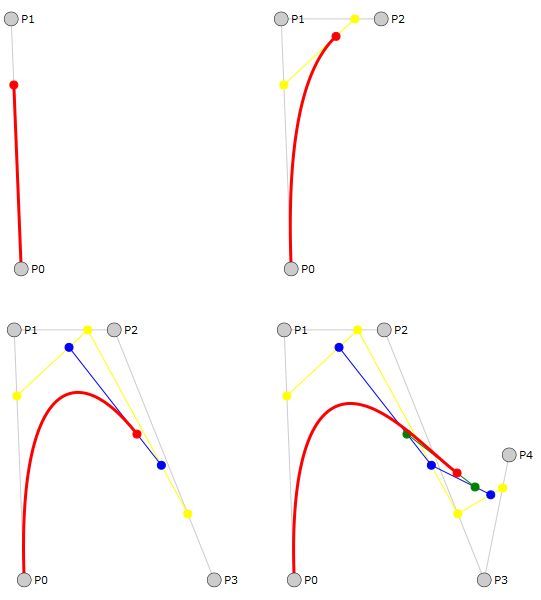SVG动画演示贝塞尔曲线(1-4阶)绘制过程
贝塞尔曲线是我们大陆的叫法,英文名是Bézier Curve,港澳台称为貝茲曲線,新加坡马来西亚称为贝济埃曲线。
先看一下效果图: 点击这里查看动画效果
维基百科中的贝塞尔曲线条目中的几个GIF动画很漂亮,顺路贴上来。
核心Javscript代码:
var w = 250,
h = 300,
t = .5,
delta = .01,
padding = 10,
points = [{x: 10, y: 250}, {x: 0, y: 0}, {x: 100, y: 0}, {x: 200, y: 250}, {x: 225, y: 125}],
bezier = {},
line = d3.svg.line().x(x).y(y),
n = 4,
orders = d3.range(2, n + 2);
var vis = d3.select("body").selectAll("svg")
.data(orders)
.enter().append("svg:svg")
.attr("width", w + 2 * padding)
.attr("height", h + 2 * padding)
.append("svg:g")
.attr("transform", "translate(" + padding + "," + padding + ")");
update();
vis.selectAll("circle.control")
.data(function(d) { return points.slice(0, d) })
.enter().append("svg:circle")
.attr("class", "control")
.attr("r", 7)
.attr("cx", x)
.attr("cy", y)
.call(d3.behavior.drag()
.on("dragstart", function(d) {
this.__origin__ = [d.x, d.y];
})
.on("drag", function(d) {
d.x = Math.min(w, Math.max(0, this.__origin__[0] += d3.event.dx));
d.y = Math.min(h, Math.max(0, this.__origin__[1] += d3.event.dy));
bezier = {};
update();
vis.selectAll("circle.control")
.attr("cx", x)
.attr("cy", y);
})
.on("dragend", function() {
delete this.__origin__;
}));
vis.append("svg:text")
.attr("class", "t")
.attr("x", w / 2)
.attr("y", h)
.attr("text-anchor", "middle");
vis.selectAll("text.controltext")
.data(function(d) { return points.slice(0, d); })
.enter().append("svg:text")
.attr("class", "controltext")
.attr("dx", "10px")
.attr("dy", ".4em")
.text(function(d, i) { return "P" + i });
var last = 0;
d3.timer(function(elapsed) {
t = (t + (elapsed - last) / 5000) % 1;
last = elapsed;
update();
});
function update() {
var interpolation = vis.selectAll("g")
.data(function(d) { return getLevels(d, t); });
interpolation.enter().append("svg:g")
.style("fill", colour)
.style("stroke", colour);
var circle = interpolation.selectAll("circle")
.data(Object);
circle.enter().append("svg:circle")
.attr("r", 4);
circle
.attr("cx", x)
.attr("cy", y);
var path = interpolation.selectAll("path")
.data(function(d) { return [d]; });
path.enter().append("svg:path")
.attr("class", "line")
.attr("d", line);
path.attr("d", line);
var curve = vis.selectAll("path.curve")
.data(getCurve);
curve.enter().append("svg:path")
.attr("class", "curve");
curve.attr("d", line);
vis.selectAll("text.controltext")
.attr("x", x)
.attr("y", y);
vis.selectAll("text.t")
.text("t=" + t.toFixed(2));
}
function interpolate(d, p) {
if (arguments.length < 2) p = t;
var r = [];
for (var i=1; i<d.length; i++) {
var d0 = d[i-1], d1 = d[i];
r.push({x: d0.x + (d1.x - d0.x) * p, y: d0.y + (d1.y - d0.y) * p});
}
return r;
}
function getLevels(d, t_) {
if (arguments.length < 2) t_ = t;
var x = [points.slice(0, d)];
for (var i=1; i<d; i++) {
x.push(interpolate(x[x.length-1], t_));
}
return x;
}
function getCurve(d) {
var curve = bezier[d];
if (!curve) {
curve = bezier[d] = [];
for (var t_=0; t_<=1; t_+=delta) {
var x = getLevels(d, t_);
curve.push(x[x.length-1][0]);
}
}
return [curve.slice(0, t / delta + 1)];
}
function x(d) { return d.x; }
function y(d) { return d.y; }
function colour(d, i) {
return d.length > 1 ? ["#ccc", "yellow", "blue", "green"][i] : "red";
}
